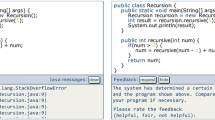Abstract
Responding appropriately to student errors requires some model of the student with which to determine the most likely cause of the errors. In a conventional CAI program the model is implicit and is represented by the hard-coded relationship between errors and corrective feedback. In an intelligent tutoring system (ICAI program) student modeling can be done dynamically as student responses are generated. In both cases, multiple inputs about causally related variables obtained prior to any tutoring provides a rich source of information about the cognitive state of the student. As a result it is possible to produce a more robust student model and to generate a more effective sequence of lessons to repair the student's misconceptions. Examples of such an approach used in the implementation of both a CAI and a ICAI program are presented.
Preview
Unable to display preview. Download preview PDF.
Similar content being viewed by others
References
Barbara Brecht, Marlene Jones. Student models: the genetic graph approach. International Journal of Man-Machine Studies. 1988, Vol. 28, pp. 483–504.
Richard R. Burton. Diagnosing bugs in a simple procedural skill. In Derek. H. Sleeman, John. S. Brown, (Eds.), Intelligent Tutoring Systems. Academic Press, 1982, pp. 157–183.
C. John Dickinson, C. H. Goldsmith, D. L. Sackett. Macman: a digital computer model for teaching some basic principles of hemodynamics. Journal of Clinical Computing. 1973. Vol. 2, pp. 42–50.
Dedre Gentner, Albert L. Stevens (Eds.). Mental Models. Lawrence Erlbaum Associates, 1983.
Nakhoon Kim, Martha Evens, Joel A. Michael, Allen A. Rovick. CIRCSIMTUTOR: An intelligent tutoring system for circulatory physiology. In Hans Maurer (Ed), Computer Assisted Learning (Proceedings of the International Conference on Computer-Assisted Learning. Springer-Verlag, 1989, pp. 254–266.
Jun Li, Allen A. Rovick, Joel A. Michael. ABASE: A hypermedia-based tutoring and authoring system. Paper accepted for presentation at the 4th ICCAL Conference, 1992.
Stuart A. Macmillan, D. Emme, M. Berkowitz. Instructional planner. In Joseph Psotka, L. D. Massey, S. A. Mutter (Eds.). Intelligent Tutoring Systems: Lessons Learned. Lawrence Erlbaum Associates Inc, 1988, pp. 229–256.
Joel A. Michael, Allen A. Rovick. The uses of CBE in teaching the functions of complex systems. Proceedings of the 27th International Association for the Development of Computer-based Instructional Systems Meeting, New Orleans, LA, 1986, pp. 43–48.
Joel A. Michael, Allen A. Rovick. Does use of a CBE program assist students to learn? Federation of American Societies for Experimental Biology Annual Meeting, Atlanta, GA, 1991, p. A1115.
Allen A. Rovick, Joel A. Michael. CIRCSIM: An IBM PC computer teaching exercise on blood pressure regulation. XXX International Union of Physiological Sciences Congress, Vancouver, Canada, 1986, p. 318.
Allen A. Rovick, Joel A. Michael. GASP-PC: A computer teaching program on the chemical control of breathing. Federation of American Societies for Experimental Biology Annual Meeting, Atlanta, GA, 1991, p. 474.
Leemseop Shim, Martha Evens, Joel A. Michael, Allen A. Rovick. Effective cognitive modeling in an intelligent tutoring system for cardiovascular physiology. Proceedings of the 4th Annual IEEE Symposium on Computer-Based Medical Systems, Baltimore, MD, 1991, pp. 338–345.
Patrick Suppes. The future of intelligent tutoring systems: problems and potentials. Presented at ITS-88, Montreal, Canada, 1988.
Kurt VanLehn. Student modeling. In Martha C. Poison, J. Jeffrey Richardson (Eds). Foundations of Intelligent Tutoring Systems. Lawrence Erlbaum Associates Publishers, 1988, pp. 55–78.
Etienne Wenger. Artificial Intelligence and Tutoring Systems. Morgan Kaufmann Publishers, Inc., 1987.
Chong W. Woo, Martha Evens, Joel Michael, Allen Rovick. Dynamic instructional planning for an intelligent physiology tutoring system. Proceedings of the 4th Annual IEEE Symposium on Computer-Based Medical Systems, Baltimore, MD, 1991, pp. 226–233.
Masoud Yazdani. Intelligent tutoring systems: an overview. In Robert W. Lawler, Masoud Yazdani (Eds.). Artificial Intelligence and Education, Vol.1. Ablex Publishing, 1987, pp. 183–201.
Author information
Authors and Affiliations
Editor information
Rights and permissions
Copyright information
© 1992 Springer-Verlag Berlin Heidelberg
About this paper
Cite this paper
Michael, J., Rovick, A., Evens, M., Shim, L., Woo, C., Kim, N. (1992). The uses of multiple student inputs in modeling and lesson planning in CAI and ICAI programs. In: Tomek, I. (eds) Computer Assisted Learning. ICCAL 1992. Lecture Notes in Computer Science, vol 602. Springer, Berlin, Heidelberg. https://doi.org/10.1007/3-540-55578-1_90
Download citation
DOI: https://doi.org/10.1007/3-540-55578-1_90
Published:
Publisher Name: Springer, Berlin, Heidelberg
Print ISBN: 978-3-540-55578-0
Online ISBN: 978-3-540-47221-6
eBook Packages: Springer Book Archive




